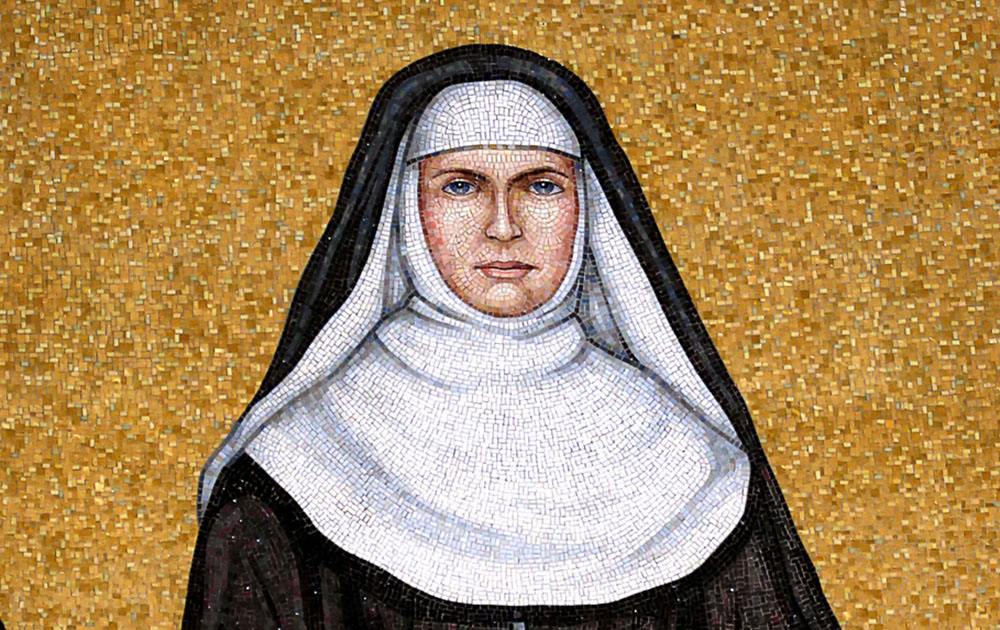After nearly 50 religious orders refused Hawaiian King Kalakaua’s invitation to care for the victims of leprosy in his kingdom, St. Marianne Cope said “yes.” The Mother Provincial of the Sisters of St. Francis in Syracuse, New York, responded wholeheartedly to the request, saying, “I am hungry for the work, and I wish with all my heart to be one of the chosen ones, whose privilege it will be to sacrifice themselves for the salvation of the souls of the poor Islanders. … I am not afraid of any disease, hence, it would be my greatest delight even to minister to the abandoned ‘lepers.’”
The family of Barbara Koob — St. Marianne’s birth name — emigrated from Germany for America the year after her birth in 1838, and the immigrant family’s name became Cope. Although she felt called to religious life, Cope began factory work after eighth grade to help her family’s finances when her father became ill. When her father died in 1862, Cope could finally profess vows with the Franciscan Sisters in Syracuse. The newly named Sister Marianne soon began service in German immigrant schools. Her leadership skills were apparent early on, which led her to establishing hospitals in central New York State and a tenure as administrator of St. Joseph Hospital in Syracuse. Cope’s intelligence and interpersonal abilities were apparent, and all who knew her were aware that God was her sole inspiration. She became provincial in 1877.
Already secure in her calling, God called Cope to an even more sacrificial life when she responded favorably to King Kalakaua’s request. It might seem astounding that Cope responded with such ease to something she never imagined in her ministry. However, it’s easily understandable when one is more acquainted with her willingness to serve the Lord. At her beatification in 2005, Cardinal José Saraiva Martins recalled Cope’s dependence on God’s providence, saying, “She left everything and abandoned herself completely to the will of God, to the call of the Church and to the demands of her new brothers and sisters. She put her own health and life at risk.”
Cope and six Franciscan sisters arrived in Hawaii in 1883 and operated hospitals and schools among the leper community. Initially overseeing a hospital for the victims of the disease in Oahu, she later established a home to care for children of leper victims. There, Cope and her sisters cared for the children with a mother’s love. Known for her undying optimism and trust in God’s providence, Cope taught her sisters about their role among the lepers, saying they were “to make life as pleasant and as comfortable as possible for those of our fellow creatures whom God has chosen to afflict with this terrible disease.”
Cope carried on her motherly love of the lepers when she opened a home for women and girls on the island of Molokai. This was a further sacrifice because she knew going to the leper’s island-prison meant essentially she was isolated from the outside world forever. While on Molokai, she developed a close relationship with St. Jozef Damien De Veuster after he was diagnosed with leprosy. Cope lovingly took care of this “apostle to the lepers” in his final days and carried on much of his work among the men’s section of the leper colony after his 1889 death. In 1895, she secured religious brothers to staff it.
Cope led the sisters in the Hawaiian missions until her health began to decline after a life of tireless work as an embodiment of the Good Samaritan. Miraculously, however, she never suffered from leprosy. An 80-year-old Cope died on Molokai on Aug. 9, 1918, originally buried on the island. Never returning to her Syracuse motherhouse in her lifetime, Cope’s relics arrived in Syracuse in 2005 and stayed there until enshrinement in the Honolulu cathedral in 2014. Cope was canonized in 2012 by Pope Benedict XVI, who said she, “showed the highest love, courage and enthusiasm.”
Her feast day is Jan. 23.
Michael Heinlein is editor of Simply Catholic.

